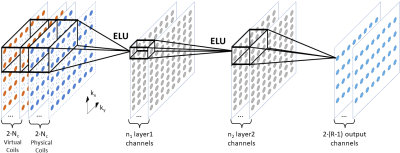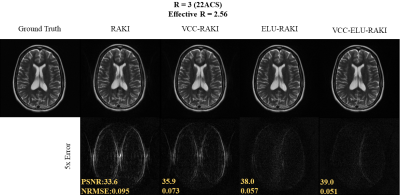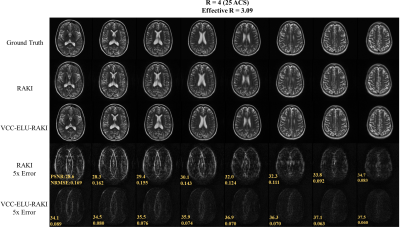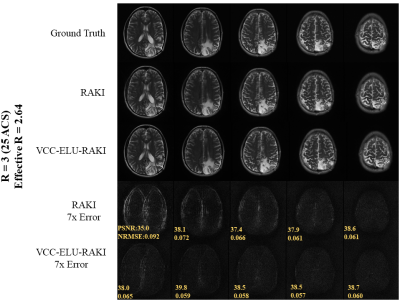4355
Advancing RAKI Parallel Imaging Reconstruction with Virtual Conjugate Coil and Enhanced Non-Linearity
Christopher Man1,2, Zheyuan Yi1,2, Vick Lau1,2, Jiahao Hu1,2, Yujiao Zhao1,2, Linfang Xiao1,2, Alex T.L. Leong1,2, and Ed X. Wu1,2
1Laboratory of Biomedical Imaging and Signal Processing, The University of Hong Kong, Hong Kong SAR, China, 2Department of Electrical and Electronic Engineering, The University of Hong Kong, Hong Kong SAR, China
1Laboratory of Biomedical Imaging and Signal Processing, The University of Hong Kong, Hong Kong SAR, China, 2Department of Electrical and Electronic Engineering, The University of Hong Kong, Hong Kong SAR, China
Synopsis
RAKI is recently proposed as a deep learning version of GRAPPA, which trains on auto-calibration signal (ACS) to estimate the missing k-space data. However, RAKI requires a larger amount of ACS for training and reconstruction due to its multiple convolutions which resulting in lower effective acceleration. In this study, we propose to incorporate the virtual conjugate coil and enhanced non-linearity into the RAKI framework to improve the noise resilience and artifact removal at high effective acceleration. The results demonstrate that such strategy is effective and robust at high effective acceleration and in presence of pathological anomaly.
Introduction
Parallel Imaging (PI) techniques exploiting the multichannel spatial encoding in either image domain or k-space are widely used to reduce scan time in clinical routine. GRAPPA1 is commonly used by linearly interpolating the missing k-space data from neighbouring acquired data across all channels. Recently, RAKI2 was proposed as a deep learning (DL) version of GRAPPA to additionally model the non-linear estimation of the kernel. However, RAKI requires a larger amount of ACS for training and reconstruction due to its multiple convolutions, which resulting in lower effective acceleration.In this study, we propose virtual-conjugate-coil RAKI (VCC-ELU-RAKI) to enable a robust and effective reconstruction at high effective acceleration. It incorporates extra encoding power by utilizing the characteristic of the conjugate symmetry and exponential linear-unit (ELU)3 by enhancing the non-linearity of the network. The proposed strategy effectively improves the noise resilience at high effective acceleration and significantly reduces the aliasing artifacts without increasing the number of learnable parameters of network and avoiding overfitting.
Methods
Conjugate Symmetry of k-Space:MR image data is complex-valued with the phase distribution depending on Bo field inhomogeneity and pulse sequence4. By taking advantage of the virtual coil containing the complex-conjugate of the k-space data, additional image and coil phase information can be utilized to improve the reconstruction quality of phase-constrained parallel MRI methods5.
In VCC-GRAPPA6, such symmetric conjugate characteristic of k-space can be treated as virtual coils in addition to the actual physical coils, essentially doubling the information involved in learning the GRAPPA kernel, thereby improving the reconstruction conditions.$$S_{i+N}(k)=S_{i}^{*}(-k)\qquad\text{for}\ i=1,2,...,N\,\text{coils}\quad(1)$$Similarly, this additional image and coil phase information can be incorporated into deep learning-based k-space interpolation approach (e.g. RAKI)to further improve the reconstruction performance.
VCC-ELU-RAKI:
For RAKI, we implemented a 3-layer 2D network according to the original paper. It consisted of 3 convolutional layers with kernel sizes of 5x2, 1x1 and 3x3 respectively and 2 non-linear activation functions. The network treated the zero-filled undersampled k-space as input with separate channels for real and imaginary components of the complex signal and outputs 2·(R-1) channels per coil, which were subsequently combined to form the complete k-space.
Regarding VCC, additional virtual coils were synthesized according to equation (1) by taking the complex conjugate symmetry of k-space data in both ACS and undersampled region. The virtual coils were then concatenated along the channel dimension of the network and standard RAKI reconstruction with additional virtual coils was performed. This takes advantage of the additional phase information provided by the conjugate symmetry to further improve the noise resilience in comparison to RAKI at high effective acceleration.
To further improve the reconstruction performance, we replaced ReLU activation function with ELU to enhance the non-linearity of the network for better convergence property3 and less prone to overfitting7. This drives the network to reach local minima with better representational power8 for estimating peripheral k-space data without increasing the number of learnable parameters in the network.
Evaluation:
The NYU fastMRI T2 brain dataset9 was used with compressed to 4 channels. The k-space data was retrospectively undersampled with acceleration R = 3 and 4 using 1D cartesian uniform sampling masks with 22 and 25 ACS respectively.
PSNR and NRMSE were used to quantitatively evaluate the reconstructed images. The proposed method was also evaluated with images containing pathological anomaly.
Results
Figure 2 shows the improved noise suppression from VCC and artifact removal from ELU and the joint benefit by combining them into the RAKI framework at R=3 (effective Reff=2.56) in 4-channel T2-weighted data. Figure 3 demonstrates the potential of the proposed method for R=4 (effective Reff=3.09) on 4-channel data, whereas RAKI exhibits mild noise amplification and severe residual artifact. Figure 4 illustrates the robustness of the proposed method on anomaly. Moreover, VCC-ELU-RAKI consistently shows improved noise suppression and artifact removal than RAKI.Discussion and Conclusion
The proposed strategy improves the framework of RAKI by jointly integrating conjugate phase information and enhanced non-linearity. In contrast to RAKI, it effectively and robustly reduces the artifacts and suppresses the noise amplification at high effective acceleration and in presence of anomaly.Acknowledgements
This work was supported in part by Hong Kong Research Grant Council (R7003-19F, HKU17112120 and HKU17127121 to E.X.W., and HKU17103819, HKU17104020 and HKU17127021 to A.T.L.L.), and Lam Woo Foundation to E.X.W..References
1. M. A. Griswold et al., “Generalized Autocalibrating Partially Parallel Acquisitions (GRAPPA),” Magn. Reson. Med., vol. 47, no. 6, pp. 1202–1210, 2002.2. M. Akçakaya, S. Moeller, S. Weingärtner, and K. Uğurbil, “Scan-specific robust artificial-neural-networks for k-space interpolation (RAKI) reconstruction: Database-free deep learning for fast imaging,” Magn. Reson. Med., vol. 81, no. 1, pp. 439–453, 2019.
3. D. A. Clevert, T. Unterthiner, and S. Hochreiter, “Fast and accurate deep network learning by exponential linear units (ELUs),” 4th Int. Conf. Learn. Represent. ICLR 2016 - Conf. Track Proc., 2016.
4. J. D. Willig-Onwuachi, E. N. Yeh, A. K. Grant, M. A. Ohliger, C. A. McKenzie, and D. K. Sodickson, “Phase-constrained parallel MR image reconstruction,” J. Magn. Reson., vol. 176, no. 2, pp. 187–198, Oct. 2005.
5. M. Blaimer, M. Heim, D. Neumann, P. M. Jakob, S. Kannengiesser, and F. A. Breuer, “Comparison of phase-constrained parallel MRI approaches: Analogies and differences,” Magn. Reson. Med., vol. 75, no. 3, pp. 1086–1099, Mar. 2016.
6. M. Blaimer, M. Gutberlet, P. Kellman, F. A. Breuer, H. Köstler, and M. A. Griswold, “Virtual coil concept for improved parallel MRI employing conjugate symmetric signals,” Magn. Reson. Med., vol. 61, no. 1, pp. 93–102, 2009.
7. N. S. Keskar, J. Nocedal, P. T. P. Tang, D. Mudigere, and M. Smelyanskiy, “On large-batch training for deep learning: Generalization gap and sharp minima,” 5th Int. Conf. Learn. Represent. ICLR 2017 - Conf. Track Proc., 2017.
8. P. Izmailov, D. Podoprikhin, T. Garipov, D. Vetrov, and A. G. Wilson, “Averaging weights leads to wider optima and better generalization,” 34th Conf. Uncertain. Artif. Intell. 2018, UAI 2018, vol. 2, pp. 876–885, 2018.
9. Zbontar J, Knoll F, Sriram A, et al. “fastMRI: An open dataset and benchmarks for accelerated MRI,” 2018, arXiv preprint arXiv:1811.08839.
Figures

Fig. 1. The architecture of the proposed VCC-ELU-RAKI. Virtual coils are generated by taking the complex conjugate symmetry of k-space data and are concatenated along the channel dimension, which doubles the number of training data. ELU replaces ReLU for enhanced non-linearity. The kernel size of the convolution are 5x2, 1x1, and 3x2 respectively. The number of channels is 32 and 8, respectively (n1=32 and n2=8).

Fig. 2. Comparison between RAKI, VCC-RAKI, ELU-RAKI, and VCC-ELU-RAKI on 4-channel T2-weighted data at R=3 with 22 ACS (effective Reff=2.56). VCC-RAKI benefits from symmetric complex conjugate signal and shows improved noise resilience compared to RAKI. Enhanced non-linearity from ELU better removes artifact. VCC-ELU-RAKI takes advantages of both VCC and non-linearity and shows improved performance.

Fig. 3. Comparison between RAKI and VCC-ELU-RAKI on 4-channel T2-weighted data at R=4 with 25 ACS (effective Reff=3.09). RAKI exhibits severe artifact with mild noise amplification, whereas VCC-ELU-RAKI shows improved reconstruction performance with less noise amplification and artifact.

Fig. 4. Comparison between RAKI and VCC-ELU-RAKI on 4-channel T2-weighted data at R=3 with 22 ACS (effective Reff=2.56) in presence of anomaly. VCC-ELU-RAKI consistently shows improved noise resilience and better artifact removal compared to RAKI.
DOI: https://doi.org/10.58530/2022/4355